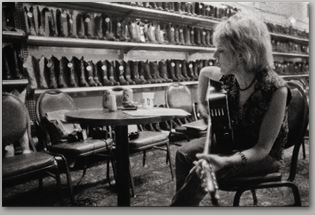
| NASHVILLE'S LOWER BROAD Photography by Bill Rouda |
|
 |
FOREWARD: |
I went to Nashville looking for something different. Iíd been living in Los Angeles for a few years after ten years of hanging out in Austin and Houston. The scene had started to change in L.A., and Iíd spoken with a couple of friends who had found a comfortable vibe in Nashville and suggested I try it. Iíd given it a shot in 1983 and hadnít liked it much. It was winter then, and my boyfriend, Clyde, and I were passing through town and staying with our friend, the songwriter Richard Dobson. To celebrate my birthday we headed downtown to get a feel for the old, true Nashville that weíd read about in books and heard about in songs. What we found were a few run-down little wino bars housing wanna-be country singers singing worn-out versions of cover songs, so we headed west and I ended up living in L.A. for the next six years. Then it was time to leave again. In January 1993 I decided to give Nashville another try. What I found was similar to the picture in my mind that Iíd left with ten years earlier. There were a couple of hipster bars, but aside from those places I didnít feel very comfortable going out anywhere in my black-leather jacket and motorcycle boots, so I really wasnít sure that I was going to stay. Then I got a call from an old friend Iíd known back in Texas. Through her I was introduced to the writer Dub Cornett, and through Dub I met the songwriter R. B. Morris, the folk artist Kevin Bradley, and Billy Rouda. We were a gang of intellectual, bohemian hipsters, and we decided that we were going to find out where something was happening or make something happen. We banded together about town with the sense that we were part of something new and undiscovered. Forget New York and L.A. We knew something was brewing underneath the broken-down, dusty, working-class bars and the worn-out cover songs of downtown Nashville. Over the next couple of years other artists began moving in and bringing their own brand of original music to those old bars. Now we had a scene. We had resurrected Lower Broad, and Billy Rouda was always there with his camera, quietly documenting the little "undiscovered" area. He had the foresight to preserve this little piece of history in the making. Through his lens Billy helped us see the real heart and soul of Nashville. Now we could invent a new story and a new song. Then things began to change. The corporations and the money moved in. They tore down the old buildings and put in a Planet Hollywood and a Hard Rock Cafe. They cleaned up Music Row. They tore down the hot dog stand and cleared out Barbara Mandrellís Tourist Shop. They moved the Country Music Wax Museum and the Midnight Jamboree. All the sweet, original landmarks that spoke of the romance and creativity of an earlier time were replaced by fern bars and condos. After we had made it hip, our little scene had been found out. Now they wanted it for their own. A long time ago downtown Nashville had been alive. It died and was brought back to life for a while. Itís gone away again, and whatís in its place is worse than the picture I had in my mind twenty years ago. But now you have Billy Roudaís photographs. They will give you a much clearer picture of what Iíve been struggling to describe. Look, listen, and learn. Lucinda Williams |